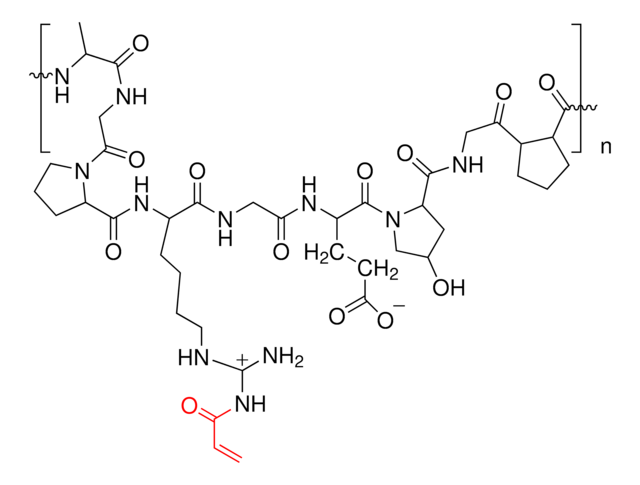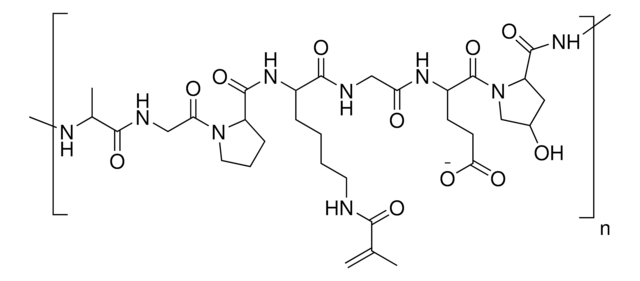922188
Low endotoxin GelMA
bloom 300, Type A, degree of substitution 80%
Synonym(s):
3D Bioprinting, GelMA, Gelatin methacrylamide, Gelatin methacrylate, Gelatin methacryloyl
Sign Into View Organizational & Contract Pricing
All Photos(1)
About This Item
UNSPSC Code:
12352202
NACRES:
NA.23
Recommended Products
Quality Level
form
powder or chunks
impurities
<10 CFU/g Bioburden
<125 EU/g Endotoxin
color
white to off-white
storage temp.
2-8°C
Looking for similar products? Visit Product Comparison Guide
Related Categories
Application
This is a low endotoxin GelMA for use in biomedical research applications.
GelMA can be used to form hydrogels for tissue engineering and 3D bioprinting. Gelatin methacryloyl (GelMA) is a polymerizable hydrogel material derived from natural extracellular matrix (ECM) components. Due to its low cost, abundance, and retention of natural cell binding motifs, gelatin has become a highly sought material for tissue engineering applications. The addition of photocrosslinkable methacrylamide functional groups in GelMA allows the synthesis of biocompatible, biodegradable, and non-immunogenic hydrogels that are stable in biologically relevant conditions and promote cell adhesion, spreading, and proliferation.
GelMA can be used to form hydrogels for tissue engineering and 3D bioprinting. Gelatin methacryloyl (GelMA) is a polymerizable hydrogel material derived from natural extracellular matrix (ECM) components. Due to its low cost, abundance, and retention of natural cell binding motifs, gelatin has become a highly sought material for tissue engineering applications. The addition of photocrosslinkable methacrylamide functional groups in GelMA allows the synthesis of biocompatible, biodegradable, and non-immunogenic hydrogels that are stable in biologically relevant conditions and promote cell adhesion, spreading, and proliferation.
Packaging
500 mg in glass bottle
Storage Class Code
11 - Combustible Solids
WGK
WGK 3
Flash Point(F)
Not applicable
Flash Point(C)
Not applicable
Certificates of Analysis (COA)
Search for Certificates of Analysis (COA) by entering the products Lot/Batch Number. Lot and Batch Numbers can be found on a product’s label following the words ‘Lot’ or ‘Batch’.
Already Own This Product?
Find documentation for the products that you have recently purchased in the Document Library.
Photocrosslinkable gelatin hydrogel for epidermal tissue engineering.
Zhao X, Khademhosseini A
Advanced Helathcare Materials (2015)
Preparation and characterization of gelatin-poly(methacrylic acid) interpenetrating polymeric network hydrogels as a pH-sensitive delivery system for glipizide
Gupta NV et al.
Indian journal of pharmacy and pharmacology, 69(1, 64-68 (2007)
Kristel W M Boere et al.
Acta biomaterialia, 10(6), 2602-2611 (2014-03-05)
Hydrogels can provide a suitable environment for tissue formation by embedded cells, which makes them suitable for applications in regenerative medicine. However, hydrogels possess only limited mechanical strength, and must therefore be reinforced for applications in load-bearing conditions. In most
Kelly M C Tsang et al.
Advanced functional materials, 25(6), 977-986 (2015-09-04)
Hydrogels are often employed as temporary platforms for cell proliferation and tissue organization in vitro. Researchers have incorporated photodegradable moieties into synthetic polymeric hydrogels as a means of achieving spatiotemporal control over material properties. In this study protein-based photodegradable hydrogels
Heemin Kang et al.
Acta biomaterialia, 10(12), 4961-4970 (2014-08-26)
Human induced pluripotent stem cells (hiPSC) are a promising cell source with pluripotency and self-renewal properties. Design of simple and robust biomaterials with an innate ability to induce lineage-specificity of hiPSC is desirable to realize their application in regenerative medicine.
Our team of scientists has experience in all areas of research including Life Science, Material Science, Chemical Synthesis, Chromatography, Analytical and many others.
Contact Technical Service




